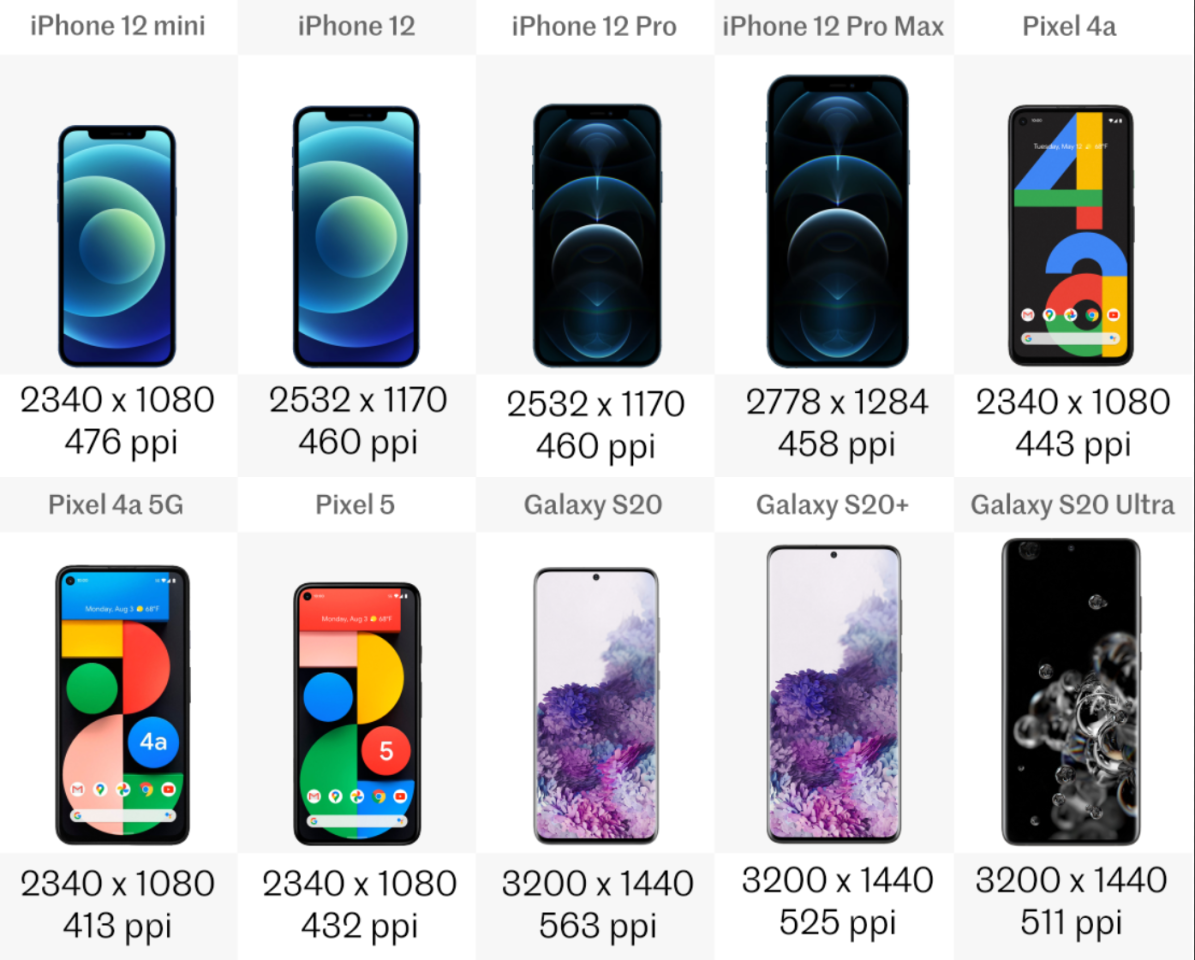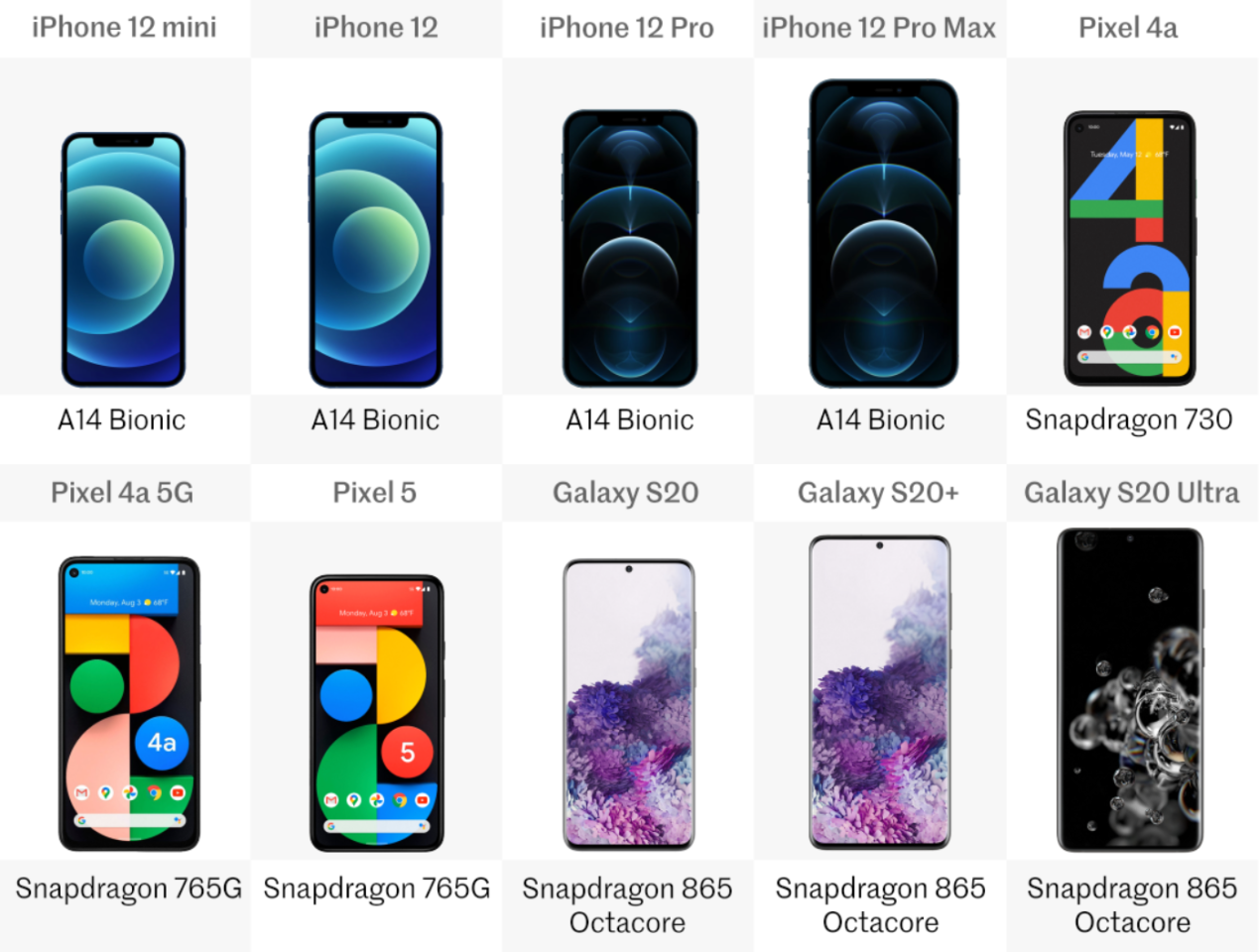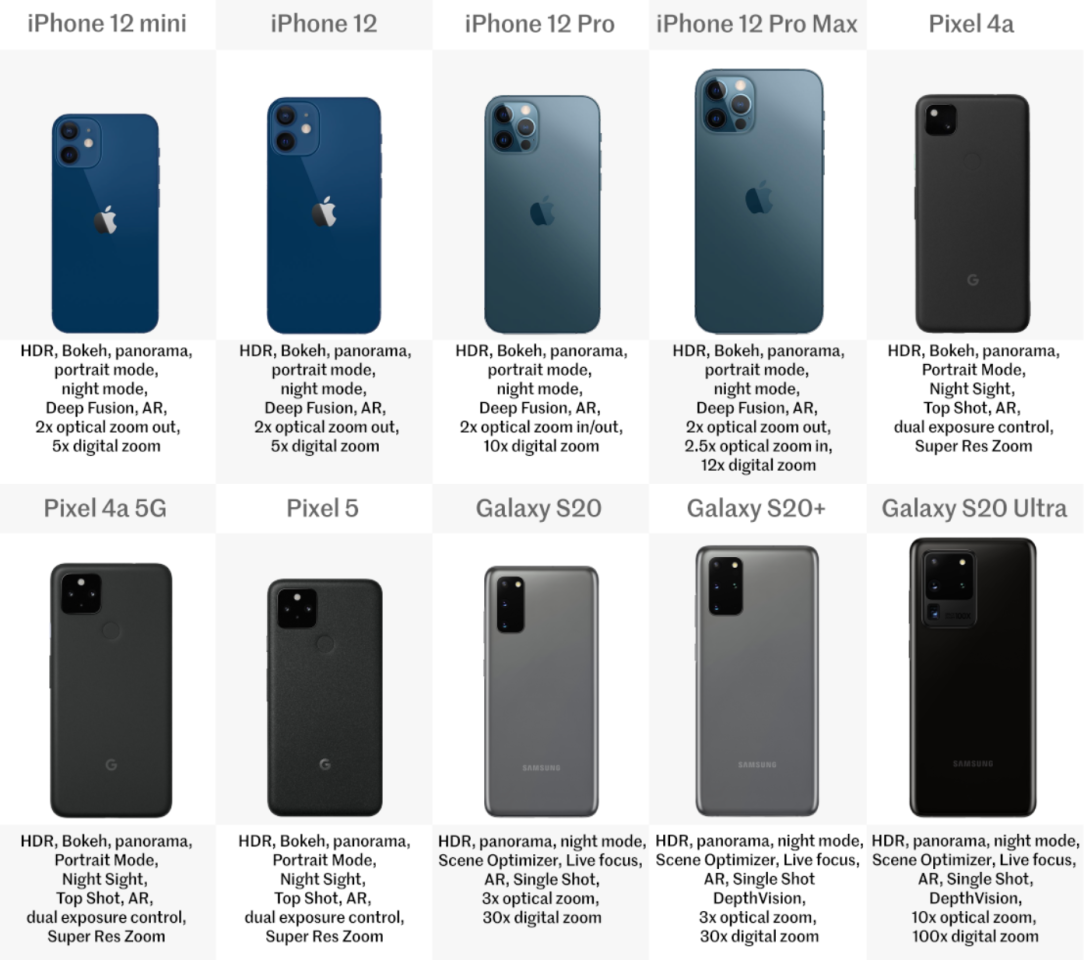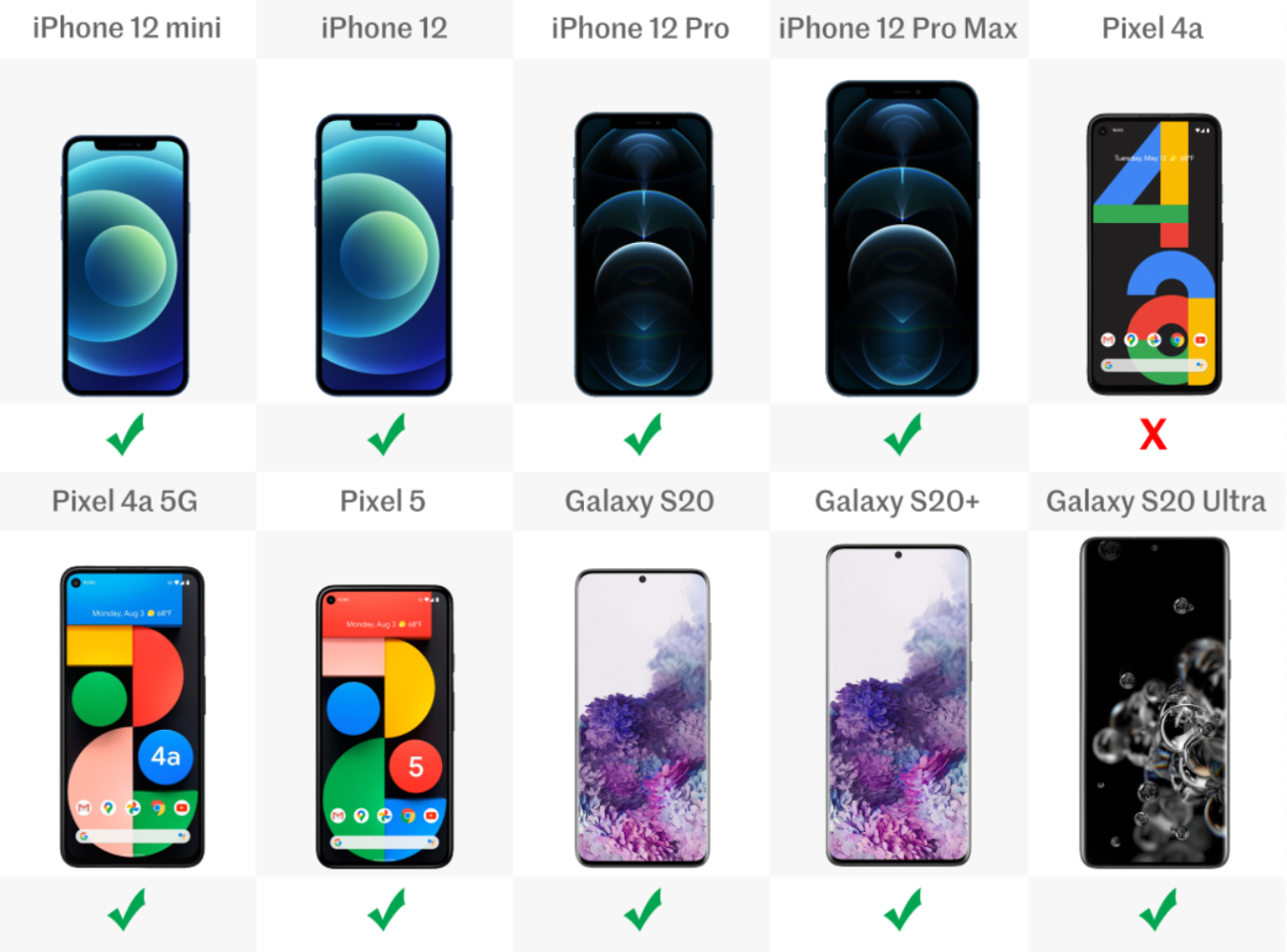All of the major smartphones of 2020 have been revealed and released, meaning it’s finally time to sit some of them side by side and see how they stack up. To help you decide which one is best for you, New Atlas compares the specs and features of the iPhone 12 mini, 12, 12 Pro and 12 Pro Max, the Google Pixel 4a, 4a 5G and 5, and the Samsung Galaxy S20, S20+ and S20 Ultra.
Of course, it’s impossible to squeeze in every phone that came out this year, so for this comparison we focused on the heavy hitters of Apple, Google and Samsung. Just within those three companies are 10 devices that run the gamut between entry-level and premium. So what are the actual differences between them all?Size

The iPhone 12 mini lives up to its name, coming in as the smallest of the bunch by quite a margin. After that it’s almost a tie between two Pixels, the 4a and 5, which are within 1 mm of each other in each dimension.
Next are the iPhone 12 and 12 Pro, which are wrapped in the exact same shell. Go up 5 mm taller and you get to the first Galaxy on the list, the S20. Then there’s the Pixel 4a 5G, just 2 mm taller and 5 mm wider.
The premium phones are all hovering above 160 mm, making these some of the biggest devices in recent years. The iPhone 12 Pro Max is one of the widest at over 78 mm, while the Galaxy S20+ is just a fraction of a millimeter taller but 5 mm narrower. And the biggest beast of them all is the Galaxy S20 Ultra, at a pocket-ripping 66.9 x 76 x 8.8 mm.Weight

These phones vary by almost 100 g across the range – that’s equivalent to 20 US nickels. While weight isn’t the most important factor in choosing a phone, it could help sway you if you’d rather not feel like you’re lugging around enough change to choke a vending machine.
Generally speaking, the iPhones are heavier for their sizes, thanks at least in part to its sturdier build materials. Inversely, the Pixel 4a and 4a 5G are much lighter than their size would suggest, due to their plastic backing. The 5G versions of the Galaxy S20+ and S20 Ultra are both two grams heavier than the standard models.Colors

Whether you want flashy colors or something muted to just stick a case over the top of, there are quite a range of options on offer here.
The iPhone 12 and 12 mini come in basic black or white, as well as brighter reds, greens and blues. For the premium iPhones, Apple has gone for the usual gold and silver finishes, a darker “Graphite,” or a distinguished “Pacific Blue.”
The Pixel lineup has the narrowest options – to paraphrase Henry Ford, you can have a Pixel 4a in any color you want, as long as it’s black. The 4a 5G adds a white version, while the Pixel 5 introduces an olive green offering Google calls Sorta Sage.
Samsung tries to dress its colors up with cool-sounding adjectives – its black and gray models are “Cosmic,” while its pastel blues and pinks are “Cloud” colors.Build

Google has gone for affordability this year, and part of that means wrapping the Pixel 4a and 4a 5G in a cheaper plastic backing. The Pixel 5 has an aluminum back with a resin coating.
All the other phones are all made with glass front and back ringed in metal frames – aluminum for the Galaxy series and the iPhone 12 and 12 mini, and stainless steel for the iPhone 12 Pro and Pro Max.
For the first time, Apple has now added a ceramic shield to all four iPhones, which it claims makes the screens four times more resistant to breaks and scratches when dropped. Plus, they’re also now equipped with magnets that attach to new accessories like wallets, cases and chargers.Display size

The average phone screen is quickly heading north of 6 inches, and that trend continues here. The iPhone mini looks positively petite at just 5.4 in, while the Pixel 4a is only slightly bigger at 5.8 in.
Next up is the Pixel 5 on 6 in, followed closely by the iPhone 12 and 12 Pro at 6.1. The Pixel 4a 5G and Galaxy S20 are likewise tied on 6.2 in.
Then there’s a half-inch gap before the iPhone 12 Pro Max and Galaxy S20+, on a respectable 6.7 in. And once again leading the pack in size is the S20 Ultra, sporting a 6.9 in screen.Screen-to-body ratio

If you’re going to have a big device you might as well have a big screen on it, so part of the smartphone race has been about squeezing as much display onto the front as possible. And as such, all of these phones have a screen-to-body ratio over 80 percent.
The Galaxy lineup boasts the best ratios – all three have thin borders around the screen and a tiny “hole-punch” housing the camera, so that the display covers about 90 percent of their faces.
The iPhones are the next biggest bezel-banishers, with their notched design giving them ratios between 85 and 87.4 percent.
The Pixels have on average the smallest ratios – which is odd, given they also use a hole punch design. The difference appears to be made up in thicker bezels, giving them ratios between 83 and 86 percent.Display resolution

All 10 of these phones have resolutions in the murky area north of Full HD, with some approaching 4K.
The iPhone 12 mini and the three Pixels all have the same resolution, at 2340 x 1080, which is slightly above 1080p Full HD. By virtue of its smaller screen, the iPhone 12 mini ends up with the higher pixel density, at 476 pixels per inch (ppi).
Next in line is the iPhone 12 and 12 Pro, which have identical 2532 x 1170 displays at 460 ppi. The iPhone 12 Pro Max ups things a little to 2778 x 1284, with 458 ppi.
And finally, the Galaxies sport the fanciest screens of all, at 3200 x 1440 and well over 500 ppi each.Display type

While there are advantages and disadvantages to both OLED and LCD screens, the industry as a whole seems to be moving towards the former. Apple was one of the last major manufacturers to get onboard the OLED train, and now it has for basically all its devices.
Generally speaking, OLED (and its AMOLED variant) have brighter colors and deeper blacks.Processor

This generation of iPhones is powered by Apple’s latest chipset, the A14 Bionic. It’s the first processor with a 5-nanometer architecture on the smartphone market – most are still using 7-nm – and Apple brags that it’s the fastest in any smartphone ever.
All the other phones are built with Qualcomm Snapdragon chips. The three Galaxies are running the Snapdragon 865, Qualcomm’s flagship processor. The Pixels, however, have gone with the mid-range 700 series, which allow them to cut the price while still providing a reasonably speedy chip. Plus, the 765G has built-in 5G connectivity, allowing the Pixel 4a 5G and 5 to tap into this new networking service.RAM

As usual, the iPhones have the least RAM, with the iPhone 12 and 12 mini running on just 4 GB. The iPhone 12 Pro and Pro Max go up to the current standard of 6 GB, joining the Pixel 4a and 4a 5G.
The Pixel 5, Galaxy S20 and S20+ pack 8 GB of RAM, while the latter two also offer 12 GB options. And finally, the Galaxy S20 Ultra starts at 12 GB and goes up to a mammoth 16 GB, which honestly is pretty much overkill for a phone.Front camera

The Pixels have the lowest-specced selfie cams, with a simple eight-megapixel camera and a decent aperture of f/2.0. The Galaxy S20 and S20+ add an extra 2 MP and have a slightly wider aperture.
The iPhone 12 series bump things up to 12 MP, but they’re also TrueDepth 3D cameras, which power the Face ID recognition system.
The Galaxy S20 Ultra meanwhile is just showing off, with a huge 40-MP front camera.Rear cameras

Multiple rear cameras are now the norm, and apart from the Pixel 4a, you’ll find two or three cameras on each of these phones.
All three Google phones start with a 12.2-MP camera, and the 4a 5G and 5 add an ultra-wide angle lens with 16 MP.
The iPhones have a similar setup, with all four sporting a wide and ultra-wide lens with 12 MP each. The iPhone 12 Pro and Pro Max also add a 12-MP telephoto lens as well as a LiDAR depth sensor, similar to the tech used to help self-driving cars navigate.
The Galaxy S20 ad S20+ have a similar array, except their telephoto lenses have a huge 64 MP. The S20 Ultra trades off some of that extra telephoto detail and gives it to the wide-angle lens, which has a massive 108 MP.
The S20+ and Ultra also have depth-sensing cameras on the back, which don’t take pictures themselves but are used to boost photo functions like bokeh and augmented reality (AR).Photo modes

These phones all have similar photo modes, but some handle certain tasks better than others. All 10 can shoot photos with High Dynamic Range (HDR), capturing darker and lighter areas together with more accuracy. They can all stitch multiple shots together to create one big panorama. They all have some form of night mode, taking longer exposures to collect more light in darker scenes.
They all have bokeh functions (usually tied up in so-called portrait modes), which allow photographers to artfully blur the background to make the subject pop. Samsung’s Live Focus allows the Galaxy phones to adjust this after the photo has been taken.
And all 10 phones have AR features, where digital characters and objects can be overlaid on real images through the camera. As mentioned, the LIDAR on the iPhone 12 Pro and Pro Max, and the depth sensors on the Galaxy S20+ and S20 Ultra, should improve both of these effects.
Now for the unique modes. The iPhone 12 series has a feature called Deep Fusion, which captures a few exposures in a row to improve the detail at different depths, and stitches them together into one much clearer image.
The Pixels feature Dual Exposure Control, allowing users to separately adjust highlights and shadows in their photos.
The Pixels and the Galaxies have features that improve photos of moving subjects by instead capturing a short video and pulling the best stills out of it. The Pixels call it Top Shot, while the Galaxies dub it Single Take.
Samsung’s Scene Optimizer mode recognizes what kind of shot you’re taking – whether that’s faces, food, animals, scenery or sunsets – and automatically adjusts settings like exposure, contrast and white balance as needed.
The Galaxy S20+ and S20 Ultra have a clever new mode called DepthVision too, which makes use of the 3D camera to measure height, width, area and volume of objects you scan. It can also create a digital 3D rendering of the object, which can be saved, sent to friends and even added to photos and videos.
And finally, there’s the zoom. The Pixel lineup have digital zoom only, which Google calls Super Res but doesn’t specify how far it can go. The iPhone 12 and 12 mini have 5x digital zoom in, and 2x optical zoom out, thanks to the ultra-wide lens. The iPhone 12 Pro ups the digital zoom to 10x. The Pro Max goes up to 12x digital, 2.5x optical in and 2x optical out.
The Galaxy S20 and S20+ can zoom in up to 3x optically and 30x digitally, while the S20 Ultra has 10x optical zoom and a powerful 100x digital.Video modes

All 10 phones can shoot video in Full HD (1080p) and 4K resolutions at up to 60 frames per second (fps). The Galaxies are among the first phones to also be able to shoot in 8K.
They can all shoot in slow motion too. The iPhones do so in Full HD resolution at either 120 or 240 fps, while the Pixels drop back to HD (720p) when shooting at 240 fps. The Galaxies ditch the 120 fps mode altogether in favor of Super Slo-Mo, where time passes at an absolute crawl of 960 fps.
Going the other way, the iPhones and Galaxies can also speed time up to make time lapse videos.
All 10 phones have optical and electronic image stabilization (OIS/EIS).
The Galaxies can shoot HDR10+ video.
One of Apple’s impressive new tricks is the ability to apply the Dolby Vision grading technique to video while it’s being recorded. Normally a post-production step, this is the first time it’s been possible in real time, and not just in a phone – apparently even professional movie cameras can’t do it.Biometrics

The iPhones can all be unlocked using Face ID, which is Apple’s buzzword for facial recognition.
The Pixels go for the old fingerprint unlock system instead, with the sensors located on the backs of the phones.
And the Galaxies offer both, with the selfie cams allowing for quick facial scans and ultrasonic fingerprint sensors built into the lower part of the screen.Water resistance

The four iPhones, three Galaxies and the Pixel 5 have all been rated IP68 for water resistance, officially meaning they should be able to withstand being submerged in water to a depth of 1.5 m (4.9 ft) for up to 30 minutes. Apple goes a step further though and claims the iPhones can dive all the way down to 6 m (20 ft).
Of course, we don’t recommend actually putting these claims to the test, but it’s at least comforting to know that your shiny new phone should be able to shake off a spill, a splash or a quick accidental swim.
Oh, but be extra careful with the Pixel 4a and 4a 5G – they haven’t been rated at all, so there’s no telling how well they might fare.Built-in storage

Storage standards seem to hover around 128 GB at the moment, with all 10 phones offering that tier. And for the Pixels and the Galaxy S20, that’s your only option.
The iPhone 12 and 12 mini let you either half or double that, if you like. The iPhone 12 Pro and Pro Max, and Galaxy S20+ and S20 Ultra start at 128 GB and offer 256 or 512 GB models as well.
But it’s important to note that storage is directly tied to price, so for each model the more storage you choose the heavier the price tag gets.MicroSD

For the iPhones and Pixels, you’re stuck with what you start with – there’s no way to expand that storage down the track. However, the Galaxies have a MicroSD card slot, which can be used to expand storage by up to 1 TB.Battery

As usual, the iPhones have the smallest batteries in their class – you’d be hard-pressed to find an Android phone with a battery capacity below 3,000 mAh nowadays, but three of the four iPhones do. The iPhone 12 Pro Max seems more normal at 3,687 mAh, until it’s stacked up against the comparable Galaxy S20 Ultra on a whopping 5,000 mAh.
That said, Apple’s walled garden gives the company greater control over how the hardware and software run together, so they can squeeze more juice out of less raw grunt.
The Pixel 4a has a pretty petite battery, in line with its position as an entry-level phone. The Pixel 4a 5G is more generous with the juice, while the Pixel 5 and the Galaxy S20 and S20+ are all upwards of 4,000 mAh.
Numbers don’t tell the whole story though, and you should still get at least a full day’s use out of each of these devices.Fast charging

All 10 phones can be fast charged, but with the iPhones there’s a catch – you’ll need to buy a 20-W adapter separately, for an extra US$19.Wireless charging

With the exception of the Pixel 4a and 4a 5G, the other eight phones can all be wirelessly charged. None of them come with that charger though, so it will require a separate purchase no matter which camp you belong to.
The Galaxies and the Pixel 5 also have the nifty ability to wirelessly charge other devices by placing them on top of the phone. Samsung calls it PowerShare, while Google calls it Reverse Charging.5G

All of these phones except for the Pixel 4a are ready to tap into the faster 5G cellular networks, which are beginning to roll out more widely across the world. For the Galaxy phones, you'll need to make sure you're getting the right version – the 5G model is separate.Ports

For some reason, the smartphone industry has decided that the classic 3.5-mm audio jack is only for lower-end phones now. As such, only the Pixel 4a and 4a 5G have them. For all the others, you’ll need to use either Bluetooth headphones, ones with the appropriate connector, or an adapter.
The iPhones have Apple’s own Lightning port, which is used for charging or plugging in headphones – although you no longer get any in the box.
The six Android phones all have USB-C ports, used to charge the phones or, in the case of the Galaxies, plug in the included headphones.Operating system

The iPhones are all running iOS 14, Apple’s latest operating system.
The Pixel 4a 5G and 5 are running Android 11, the latest version of the ubiquitous operating system, out of the box. The Pixel 4a still comes with Android 10 pre-installed, but it’s ready to be updated straight away. The Galaxies will likely follow soon; Samsung is currently rolling out betas to certain regions.Assistant

Apple stalwart Siri is of course back again on the iPhone 12 series. Google is running its own Assistant on its Pixel devices, while Samsung’s Bixby is present and accounted for on the Galaxies.Release date

All 10 of these phones released in 2020, with the Galaxy series the first out of the gate back in March. The Pixel 4a followed in August, just before the big holiday rush. October saw the release of the Pixel 5, iPhone 12 and 12 Pro, followed by the the Pixel 4a 5G and iPhone 12 mini and Pro Max in November.Price (US$)

Apple and Samsung are constantly pushing the boundaries of how much people are willing to spend on a phone. You’re looking at at least a grand for any Galaxy or the higher end iPhones, and they go right up to an eye-watering US$1,399 for the 512 GB iPhone 12 Pro Max, or $1,599 for the 512 GB Galaxy S20 Ultra.
Google seems to have taken a step back and realized it doesn’t want to compete on that front. Instead, it’s going for the entry-level gap in the market – as such, the Pixel 4a is a steal at $349, and the 4a 5G strikes a nice balance at $499.
Even the higher-powered Pixel 5 is pretty reasonably priced at $699 for a generous 128 GB, which is where the iPhone 12 mini starts with half the storage. Starting at $799, the regular iPhone 12 isn’t a bad deal either for most people’s needs.
With all that in mind, which phone catches your fancy? If you’re still undecided, check out our other phone comparisons.































